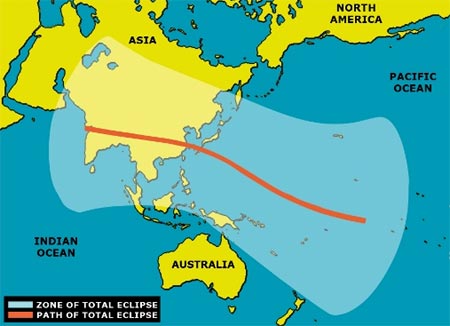The longest total eclipse of the century
On the morning of July 22, the longest total solar eclipse of the century will start from India, Nepal, Myanmar . and beyond the Pacific Ocean. In Vietnam, the most observed solar eclipse in Ha Giang (75.8%), Hanoi (67.5%) and Ho Chi Minh City is only 27.4%.
Because it is not in the total solar eclipse, it is only possible to observe part of this amazing natural phenomenon. The start of the solar eclipse is at 7am, reaching maximum at 8am and ending after 9am.
The location where the largest solar eclipse was observed was Ha Giang (75.8%), Lao Cai (75%), Bac Kan (74.5%), Hanoi (67.5%) . More in the south, the ratio is smaller: Can Tho (25.5%), My Tho (26%), HCMC (27.4%) .

The red mark is the path of the total solar eclipse and the green area is the area that can view part of this solar eclipse this time.(Photo: eclipse-glasses)
In the world, the first point to observe the total solar eclipse is the west coast of India (at 7h51 Hanoi). Due to taking place throughout 6 minutes 39 seconds, stretching from India, to China and the Pacific Ocean, this is considered the longest total solar eclipse in the 21st century.
According to astronomers, due to strong solar radiation, if using the naked eye, there is no protection to look at the sun during this time, it may cause permanent damage or eye damage. Therefore, it is necessary to have safe observation methods to protect the eyes first but harmful rays from the sun.
From 7:00 am on July 22, HCMC Amateur Astronomical Club will hold an eclipse observation at the Children's House in Ho Chi Minh City (District 3), while the Polytechnic Astronomical Club forum organizes a follow-up at Pham beach. Van Dong (Da Nang). Anyone who needs it will be instructed how to observe a solar eclipse safely.
Solar eclipse occurs when the Moon passes between the Earth and the Sun and completely obscures or partially obscures the Sun when viewed from Earth.The total solar eclipse is when the Sun is completely covered by the Moon.The glowing Sun disk is obscured by the Moon's dark rim, and it is possible to see a pale halo outside that light comes from the Sun's coronary belt.During any eclipse, the total solar eclipse can only be observed from a narrow band on the Earth's surface.At a fixed point, the total solar eclipse lasts only a few minutes (maximum 7 minutes).
- Which region in Vietnam can see the longest eclipse of the century?
- The longest total eclipse of the century will take place in July
- Why will the lunar eclipse of 27/7/2018 be unusually long?
- Vietnam welcomes the longest total solar eclipse in the 21st century
- The longest eclipse of the 21st century is coming
- Vietnamese residents and the world eagerly watch eclipse
- The longest lunar eclipse of the century around the world
- Secret to see the most special 'Blood Moon' in the 21st century on April 4 in Vietnam
- Vietnam has more than 5 hours of total lunar observations
- There will be the longest eclipse of the century!
- The final total eclipse of the decade in the South American sky
- Mars shines with the longest moon in the century
 Van Allen's belt and evidence that the Apollo 11 mission to the Moon was myth
Van Allen's belt and evidence that the Apollo 11 mission to the Moon was myth The levels of civilization in the universe (Kardashev scale)
The levels of civilization in the universe (Kardashev scale) Today Mars, the sun and the Earth are aligned
Today Mars, the sun and the Earth are aligned The Amazon owner announced a secret plan to build a space base for thousands of people
The Amazon owner announced a secret plan to build a space base for thousands of people